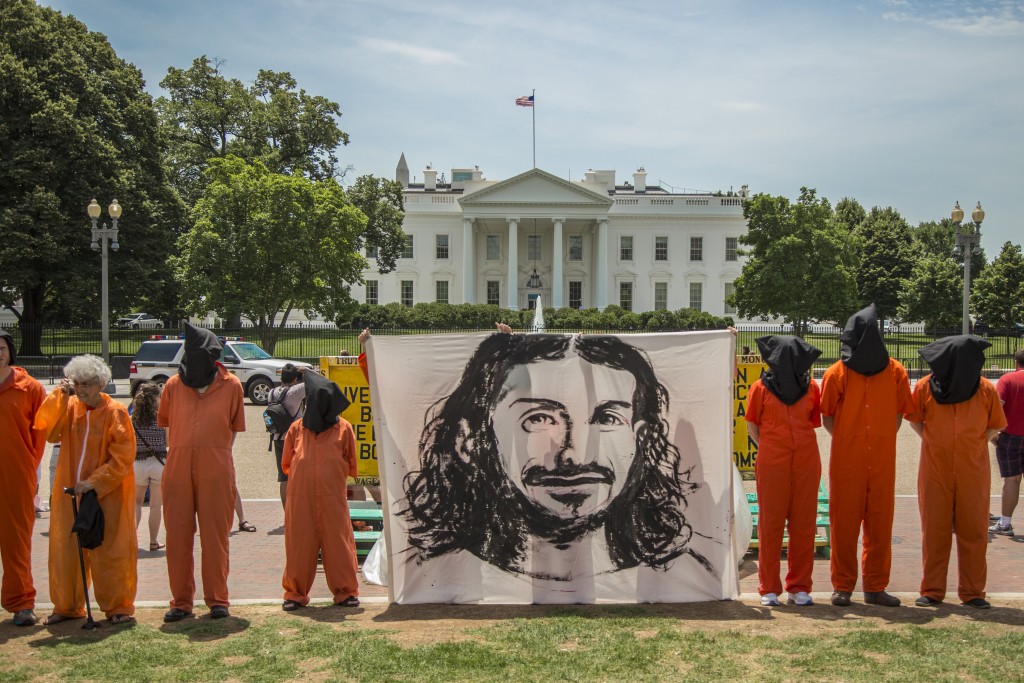His name will sound familiar to many since we last organized a nationwide fast in solidarity with Tariq on September 18, 2015 when his habeus corpus hearing happened in DC.
He is a 36- or 37-year-old citizen of Yemen. He was held at Guantánamo for 14 years. He was recommendedfor transfer to Yemen provided that certain security conditions were met in January 2010. He was transferred to Saudi Arabia on April 16, 2016.
In Guantánamo, it was alleged that Baada, who denied being a member of al-Qaeda, trained al-Farouq, and that he and a group of fighters were then assigned to the third line, about 4 km south of the front line near Kabul. It was also alleged that, after the fall of Kabul, he fled to Tora Bora, where he was put on guard duty. One of the most persistent hunger strikers at Guantánamo, he weighed 121 pounds on arrival at the prison, but in January 2006, when he was one of a handful of hunger strikers to continue after the prison-wide strike of 2005 was largely halted, he weighed just 94 pounds . In March 2007, Sami al-Haj (the al-Jazeera cameraman released in 2008) mentioned that he was one of three prisoners who had been on hunger strike — and force-fed — for the previous year.
In a Rollingstone article from June 2015, his lawyer, Omar Farrah shares : “I traveled to Guantanamo to see Ba Odah in March. I met with him again on April 21. Ba Odah had recently passed the eighth anniversary of his hunger strike, but he was not in the mood to reflect: “I don’t feel the days anymore.” Ba Odah doesn’t feel much of anything anymore. “My body gets so numb; no sensation,” he said, rapping his knuckles on the arm of his chair to illustrate the point. Apparently, this is a symptom of starvation. And with military doctors saying Ba Odah is now only 56 percent of his ideal body weight, there is no doubt he is starving. The Defense Department’s force-feeding regimen is not working. When Ba Odah lifted his prison smock, I had to look down. All I managed to write in my legal pad was “does not look like body of human; every bone visible.” Imagine liberation photos of Holocaust survivors, and you will have a sense of what I saw. Ba Odah sat back in his chair and said, “My life is not like it was. This is the hardest I have ever had it.”
Ba Odah finds redemption in protest, one organized around the principle of non-participation. Ba Odah refused to submit to a CSRT – the sham tribunals established by the Bush administration to determine who, among the hundreds of men then at Guantanamo, were “enemy combatants.” Ba Odah was similarly reluctant (and, in any event, physically unfit) to litigate his habeas petition. And, as I recounted, from 2008 until 2010, he would not even sit down with his own lawyer. It goes without saying, however, that Ba Odah’s refusal to eat is the most uncompromising form of resistance through non-participation. “I tell them again and again that I don’t want any food from them….I just don’t want it. All I want is for them leave us alone, lingering in these cells. They want me to eat, but first I have to be subjected to humiliation….The provocation is never-ending.” Therefore, Ba Odah says, his hunger strike will never end. “My method of delivering my message is through hunger strike. You can cut me to pieces, but I will not break it. I will stop on one of two conditions: I die, or I am freed and allowed to return to my family.” (Read more: http://www.rollingstone.com/politics/news/tariq-ba-odahs-eight-year-hunger-strike-at-guantanamo-bay-20150706#ixzz43Bnp14jc )
ADDITIONAL INFORMATION
Tariq Ba Odah in his own words








 He is a 44-year-old citizen of
He is a 44-year-old citizen of